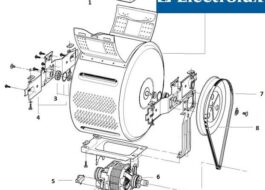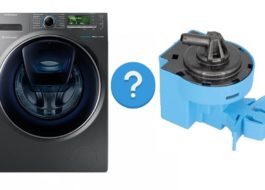Where is the water level sensor located in a Samsung washing machine?
 A special device, a pressure switch, is responsible for filling and emptying the washing machine drum. It is he who records the degree of fullness of the tank and transmits information to the control board. If there are delays in dialing or draining, then the first step is to check the functionality of this sensor. The water level sensor in a Samsung washing machine is located under the cover near the right wall of the case. It remains to figure out how to distinguish it from other elements of the machine, test and replace it.
A special device, a pressure switch, is responsible for filling and emptying the washing machine drum. It is he who records the degree of fullness of the tank and transmits information to the control board. If there are delays in dialing or draining, then the first step is to check the functionality of this sensor. The water level sensor in a Samsung washing machine is located under the cover near the right wall of the case. It remains to figure out how to distinguish it from other elements of the machine, test and replace it.
Part search and initial test
The pressure switch is a plastic “washer” and a long tube. Thanks to its convenient location, finding the sensor is not difficult - the rounded cover of the device is easy to see, and the fasteners holding it in place can be easily and without risks removed. But you should still understand that even removing the top panel from the body is considered disassembling the washing machine. If the washing machine is still under warranty, then it is better not to get into the machine, but to contact a service center.
In other cases, you can start diagnosing the pressure switch at home. We proceed like this:
- disconnect equipment from power supply and water supply;
- remove the screws holding the cover from the back wall of the case;
- push the lid away from you and lift it until the “top” comes off the grooves;
- we find the pressure switch “washer” on the right, near the front wall of the housing;
- unscrew the screw holding the housing and disconnect the fastening connectors;
- loosen the clamp with pliers;
- carefully pull out the pressure switch.

After removing the device, you should not immediately test it with a multimeter.It is much easier and faster to conduct an express test of the sensor’s performance using improvised means. It is necessary to find a tube commensurate with the diameter of the pressure switch hose, place it near the fitting and slowly blow. If 1-2 clicks are heard, then the relay responds properly to pressure. Otherwise, there is no doubt - the device is broken.
Operating principle
In addition to the location of the pressure switch, it is worth knowing the principle of its operation. The root “press” gives the necessary associations - the device operates depending on pressure. Water filling the tank increases this indicator, the air goes higher and higher through the tube. As soon as the air flow reaches a predetermined level, the contact closes, the membrane is activated, and the sensor sends a signal to the control board to stop dialing. When the drum is empty, everything happens in the reverse order.
When the sensor stops responding to water and air flows, the pressure switch loses control over the fill level of the tank, the electronic module does not receive a signal, and for safety reasons does not allow the washing machine to start working. To restore the functionality of the washing machine, you will have to conduct a full diagnostic of the device and identify the cause of the failure. The most common causes of problems are clogged tubes, damaged devices, or loose contacts.
Pressostat coil test
In addition to the primary test, it is recommended to conduct a secondary test using a multimeter. This check is the same for all pressure switches, as for Samsung, and for Bosch, LG, Ariston, Indesit and other manufacturers of washing equipment. The procedure looks like this.
- We study the electrical circuit of the sensor, find the phase and zero.
- We set up the tester to measure resistance.
- We apply the multimeter probes to the corresponding contacts of the pressure switch.
- By blowing into the tube of the device, we create pressure.
- We are waiting for the membrane to work.
Now we look at the multimeter display and evaluate the result. If the resistance value does not change when the relay is activated, then the sensor is faulty. A change in readings indicates minor breakdowns, for example, a clogged or damaged tube. The crack is likely causing the hose to lose air and not create the required pressure.
Replacing a pressure switch is quick and inexpensive. As a rule, an original sensor costs about $3-5, and the installation process takes 10-20 minutes.
Interesting:
Reader comments
- Share your opinion - leave a comment
Categories
Washing machine repair


For buyers

For users

Dishwasher

















Add a comment